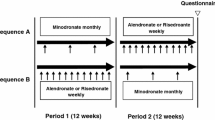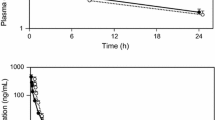Summary
Disodium clodronate (dichloromethylene bisphosphonic acid, disodium salt; CAS 22560-50-5) is a bisphosphonate that has demonstrated efficacy in patients with a variety of diseases of enhanced bone resorption. Intramuscular clodronate can determine pain at the injection site, it is therefore particularly useful to co-administer a local anaesthetic with clodronate to reduce pain at the injection site. The tolerability and pharmacokinetic of a new formulation of 100 mg disodium clodronate containing 1% lidocaine (test formulation, ChiesiFarmaceutici S.p.A) were investigated incomparisonto the same formulation without thelocal anaesthetic (Clody®) and a marketed formulation containing1% benzyl alcohol (Clasteon®). Thirty healthy female volunteers were treated according to a single dose,double-blind, randomised, three-way cross-over design. The local tolerability was investigated by assessing reddening and hardening at the injection site, and plasma CPK levels. Pain intensity was investigated on the VAS (visual analogue scale) and on the VRS (verbal rating score). Urinary clodronic acid concentrations were determined using a validated specific GC/MS/NCI assay. The statistical analysis on pain assessment showed a significant reduction of pain intensity immediately and up to 2 hours after administration of the new formulation compared to the marketed ones. CPK levels and occurrence of hardening at the injection site did not show statistically significant differences between formulations. No local redness was reported. Clodronate urinary excretion during the 48 h collection interval was not statistically different among the formulations and the 95% confidence intervals were inside the bioequivalence acceptance region, demonstrating comparable bioavailability. It was concluded that the investigated new formulation of 100 mg disodium clodronate was better tolerated than the reference marketed formulations.
Similar content being viewed by others
References
Fleisch H., Bisphosphonates. Pharmacology and use in the treatment of tumour-induced hypercalcaemic and metastatic bone disease. Drugs, 42 919–944 (1991).
Barnett B.L., Strickland L.C., Structure of disodium dihydrogen 1-hydroxyethylidenediphosphonate tetrahydrate: a bone growth regulator. Acta Crystallogr. B. 35 1212–1214 (1979).
Jung A., Bisaz S., Fleisch H., The binding of pyrophosphate and two diphosphonate on hydroxyapatite crystals. Calcif. Tissue Res., 11: 269–280 (1973).
Ljunghall S., Rastad J., Akerstrom G., Comparative effects of calcitonin and clodronate in hypercalcaemia. Bone, 8(1) S79–83 (1987).
Patel S., Lyons A.R., Hosking D.J., Drugs used in the treatment of metabolic bone disease. Clinical pharmacology and therapeutic use. Drugs, 46(4) 594–617 (1993).
Rossini M., Braga V., Gatti D., et al., Intramuscular clodronate therapy in postmenopausal osteoporosis. Bone, 24(2) 125–9 (1999).
Adami S., Passen M., Ortolani S., et al., Effects of oral alendronate and intranasal salmon calcitonin on bone mass and biochemical markers of bone turnover in postmenopausal women with osteoporosis. Bone, 17 (4) 383–90 (1995).
Reginster J.Y., Lecart M.P., Deroisy R., et al., Prevention of postmenopausal bone loss by tiludronate. Lancet, 2(8678–8679) 1469–71 (1989).
Storm T., Thamsborg G., Steiniche T., et al., Effect of intermittent cyclical etidronate therapy on bone mass and fracture rate in women with postmenopausal osteoporosis. N. Engl. J. Med., 322(18) 1265–71 (1990).
Valkema R., Vismans F.J., Papapoulos S.E., et al. Maintained improvement in calcium balance and bone mineral content in patients with osteoporosis treated with the bisphosphonate APD. Bone Miner., 5(2) 183–92 (1989).
Watts N.B., Harris S.T., Genant H.K., et al., Intermittent cyclical etidronate treatment of postmenopausal osteoporosis. N. Engl. J. Med., 323(2) 73–9 (1990).
Adami S., Bolzicco G.P., Rizzo A., et al., The use of dichloromethylene bisphosphonate and aminobutane bisphosphonate in hypercalcemia of malignancy. Bone Miner., 2(5) 395–404 (1987).
Adami S., Guarrera G., Salvagno G. et al., Sequential treatment of Paget’s disease with human calcitonin and dichloromethylene diphosphonate (C12MDP). Metab. Bone Dis. Relat. Res., 5(6) 265–7 (1984).
Adami S., Salvagno G., Guarrera G. et al., Dichloromethylene-diphosphonate in patients with prostatic carcinoma metastatic to the skeleton. J. Urol., 134(6) 1152–4 (1985).
Fleisch H. Bisphosphonates. Pharmacology and use in the treatment of tumour-induced hypercalcaemic and metastatic bone disease. Drugs, 42 (6) 919–44 (1991).
Clodronate: a new perspective in thetreatment of neoplastic bone disease. Proceedings of a meeting. Helsinki. Bone, 8(Suppl 1) :S 1–86 (1987).
Kanis J.A., McCloskey E.V., Paterson A.H., Use of diphosphonates in hypercalcaemia due to malignancy. Lancet, 335(8682) 170–1 (1990).
Yates A.J., Percival R.C., Gray R.E. et al., Intravenous clodronate in the treatment and retreatment of Paget’s disease of bone. Lancet, 1 (8444) 1474–7 (1985).
Kanis J.A., McCloskey E.V., Sirtori P. et al., Rationale for the use of clodronate in osteoporosis. Osteoporos. Int., 3(2) S23–8 (1993).
Kaastad T.S., Reikeras O., Madsen J.E. et al., Effects of clodronate on cortical and trabecular bone in ovariectomized rats on a low calcium diet. Calcif. Tissue Int., 61 (2) 158–64 (1997).
Lepola V.T.. Hannuniemi R., Kippo K., et al., Long-term effects of clodronate on growing rat bone. Bone, 18(2) 191–6 (1996).
Minaire P., Berard E., Meunier P.J., et al., Effects of disodium dichloromethylene diphosphonate on bone loss in paraplegic patients. J. Clin. Invest. 68(4) 1086–92 (1981).
Lin J.H., Bisphosphonates: a review of their pharmacokinetic properties. Bone, 18(2)75–85 (1996).
Adami S., Zamberlan N., Adverse effects of bisphosphonates. A comparative review. Drug Saf., 14(3) 158–70 (1996).
Filipponi P., Cristallini S., Rizzello E. et al., Cyclical intravenous clodronate in postmenopausal osteoporosis: results of a long-term clinical trial. Bone, 18(2) 179–84 (1996).
Filipponi P., Pedetti M., Fedeli L. et al., Cyclical clodronate is effective in preventing postmenopausal bone loss: a comparative study with transcutaneous hormone replacement therapy. J. Bone Miner. Res., 10 (5) 697–703 (1995).
Heikkinen J.E., Seiander K.S., Laitinen K., et al., Short-term intravenous bisphosphonates in prevention of postmenopausal bone loss. J. Bone Miner. Res., 12(1) 103–110 (1997).
Gnudi S., Lisi L., Fini M., et al., Effect of intramuscular clodronate on bone mass and metabolism in osteoporotic women. Int. J. Tissue React., 23(1), 33–7 (2001).
CTFA technical guidelines III. “Pharmacology and toxicology, safety testing guidelines. Guidelines forevaluating contact sensitisation potential”. The Cosmetic, Toiletry and Fragrance Association Inc. Washington D.C., USA., Curry (Ed.), pp. 7–9 G.N. Mc Ewen Jr., Anita S. (1981).
Author information
Authors and Affiliations
Rights and permissions
About this article
Cite this article
Poli, G., Mariotti, F., Corrado, M.E. et al. A tolerability andpharmacokinetic study of a newinjectable formulation of disodium clodronate in healthyfemale volunteers. European Journal of Drug Metabolism and Pharmacokinetics 29, 145–152 (2004). https://doi.org/10.1007/BF03190589
Received:
Issue Date:
DOI: https://doi.org/10.1007/BF03190589




